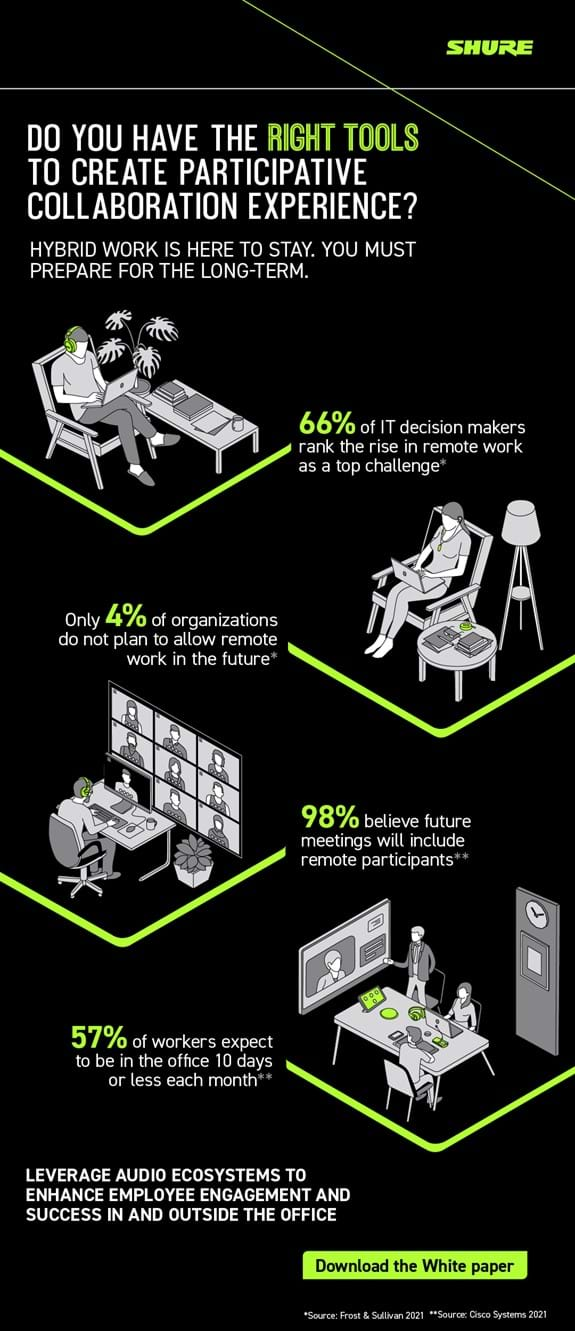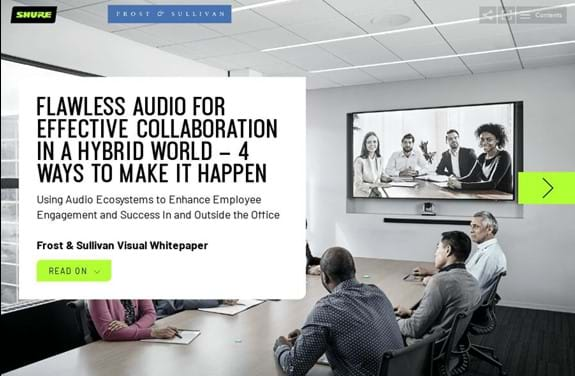Pain or pleasure – what’s the new reality of videoconferencing?
Like most IT and AV leaders, I have had to rethink the hybrid working model based on the new reality of video conferencing.
How can we give everyone equal opportunity to contribute to meetings, whether they are joining from home or attending in person?
Poor audio quality can prevent a truly collaborative experience, which is why an ecosystem of hardware, software, and accessories must feature audio in the modern communications toolkit.
Are your meetings truly collaborative in today’s hybrid world of work? Can participants joining from home see and be heard? Or is the conversation dominated by those people attending in person? This is what we refer to as ‘meeting equity’ — where everyone has an equal opportunity to contribute, from wherever they are joining a meeting.
It’s a topic that I know will resonate with IT and AV leaders as hybrid work has become the new global norm. In this landscape, we must ensure that our teams have the right collaborative tools to remain as productive as they’ve always been. And these tools include audio technology.
We are how we sound
I can hear some of you asking, ‘Why audio?’. It’s a good question. I believe that by investing in the right audio equipment, we are not only enhancing the workplace but are also providing teams with an environment where everyone feels involved, collaboration is effortless, and productivity is maximized. This eventually increases the wellbeing of all team members.
To put it another way, let me quote a colleague who simply says, ‘We are how we sound.’ What he means by this is that the sound we transmit can affect how we are perceived. The effect of audio dropping out or even not working is similar to when the picture quality is poor or too dark.

It makes a big impact on how others perceive you. Poor audio quality from a remote participant could make in-room participants and others joining remotely less likely to include them in the discussion.
This brings me back to meeting equity, which is a key topic here at Shure. A recent article in the Washington Post describes the “surprisingly disempowering” experience of an employee who felt “isolated” on joining meetings from home when she heard the “side laughter and chatter from the in-person group, many of whom she couldn’t see very well.”
In pursuit of meeting equity
This is the painful reality of many user experiences today. What’s clear is that if one person in a meeting is chronically left out of the discussion, or their remarks or ideas are not viewed as valuable, they are marginalized and placed at a disadvantage relative to other participants. In other words, the value of their input is discounted, and they are not on an equal footing with their colleagues.
The Washington Post described the problem as follows: “Between the dreaded echo that occurs when two employees on their respective devices are at proximity on a video conference to trouble hearing and seeing people who join a meeting from a conference room, many hybrid workplaces are discovering that video calls can be frustrating, complex and sometimes downright inequitable.”
Thus, as an IT leader in the AV industry, I know that the challenge is how best to ensure an inclusive meeting experience. How do we prevent our teams from falling prey to the low morale and engagement that’s been a common outcome of the increase in remote working, as cited by 56% of teams in research by Frost & Sullivan?
Integrating with collaboration platforms
The reality is that without great audio technology integrated with Microsoft Teams, Zoom, WebEx, and the other collaboration platforms that have become invaluable in the workplace, it is difficult (if not impossible) to achieve truly inclusive meetings. So, what technologies should you invest in to seamlessly connect teams with each other and give everyone an equal opportunity to contribute? How can you outfit workspaces that accommodate hybrid work and ensure flawless audio wherever your people work on a given day?
In our joint research paper with Frost & Sullivan, we recommend “an audio ecosystem comprised of hardware, software, and accessories that boost engagement and productivity by enhancing the audiovisual conferencing services that employees now use extensively.”
Such an ecosystem might bundle together microphones, speakers, and digital signal processing (DSP) that seamlessly integrate with your communication platforms to enhance the audio quality. IT and AV leaders should consider how the audio ecosystem integrates with third-party unified communications technologies to ensure that the audio infrastructure complements any existing IT investments.
Improving productivity and wellbeing
Ensuring a flawless collaborative audio experience takes time and effort. But that effort pays off with colleagues able to clearly share their opinions and expertise, no matter from where they join a meeting. Meeting fatigue can be removed with new audio tech that improves the overall experience. Morale is boosted because teams joining remotely no longer feel the in-office experience is being prioritized. All of which improves productivity and team well-being.
Attending a hybrid meeting, whether in person or remotely, should be a pleasure, not a pain for all participants. How do your teams feel about the meetings they attend?
Learn more in this latest research from Frost & Sullivan on team engagement and success with best-in-class audio ecosystems


About the author
Robin Hamerlinck
Robin Hamerlinck is Senior Vice President of Information Technology and Chief Information Officer at Shure Incorporated. She has been with Shure since 2007. She is responsible for the Company's technology need, including IT strategic planning, infrastructure development, application systems, network, operations, and security.